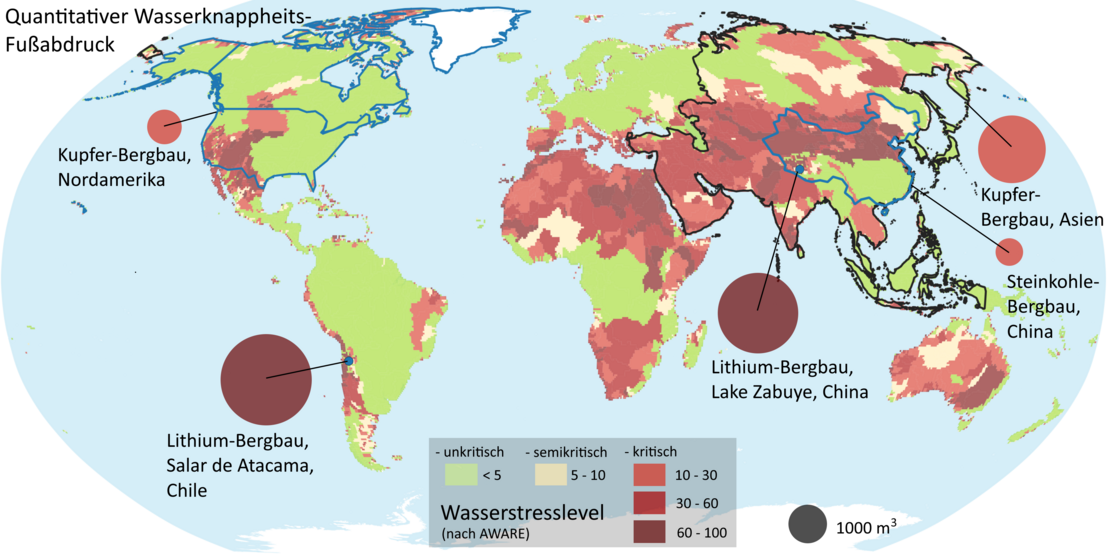This page contains automatically translated content.
This is how harmful a battery can be: Kassel researchers further develop footprint method
 Image: Anna C. Schomberg, Stefan Bringezu & Martina Flörke_CC BY 4.0.
Image: Anna C. Schomberg, Stefan Bringezu & Martina Flörke_CC BY 4.0.The water footprint, like thecarbon footprint, has become an important tool in assessing anthropogenic environmental impacts. But water is not equally precious everywhere. The Kassel researchers are further developing the footprint model and assessing how much water is available at a production site and what the consequences of consumption may be: This results in the water scarcity footprint.
Using the production of a lithium-ion storage device as an example, Anna Schomberg and Prof. Dr. Stefan Bringezu from the Center for Environmental Systems Research (CESR) and Prof. Dr.-Ing. Martina Flörke from the Ruhr University Bochum demonstrate how the water scarcity footprint can be comprehensively collected as a life cycle assessment.
In the first step, the scientists classified the risk posed by human water use and defined sub-indicators of the water scarcity footprint. "These two steps create general frameworks that allow any products to be evaluated using LCA, always according to the same scheme," explains Anna Schomberg, research associate at CESR. "In the last step, we looked at how we can represent this LCA spatially explicitly." The scientists demonstrate their method using the supply chain of lithium carbonate, which is needed to manufacture the storage device.
The water scarcity footprint of lithium carbonate
Lithium carbonate still comes primarily from Australia, China and Argentina. However, 67 percent of the world's reserves are located in the high Andes in the form of salt-rich groundwater. To extract lithium carbonate, this brine is evaporated, which consumes large quantities of water. This type of extraction may exacerbate regional water shortages in the future.
In the study, the scientists identify brine mining in Chile and China in particular as a hotspot of quantitative water use for lithium-ion storage. In both countries, the likelihood of water scarcity is already high. Therefore, the corresponding water consumptions are weighted with a location-specific factor. This makes water use in Chile and China, where different amounts of water are available in each case and thus the probability of water scarcity is also different, directly comparable. Example Chile: For a lithium storage unit with a capacity of 2 megawatt hours, for which the raw material comes from the Atacama deposits, approximately 5,600 m³ of water are used. Globally, this amounts to 33,155 m³ along the entire production chain of the storage facility.
Another result concerns qualitative water use: the additional volume of water that would theoretically be needed to dilute the global water pollution from the production of the lithium-ion storage device back to a tolerable level amounts to about 23 percent of the annual drinking water demand in Germany. Both points, quantitative and qualitative water use, are included in the concept for determining the water scarcity footprint.
Making water consumption globally comparable
The water scarcity footprint concept described is suitable for evaluating products and spatially identifying critical hotspots along international supply chains. A liter of water consumed in Chile has a greater impact than a liter consumed in Germany due to lower water availability. "Such an approach is urgently needed, especially when assessing new technologies to be used in the Western energy transition, for example, in order to avoid problem shifting from the outset," says Bringezu.
The scientists published their findings in the journal "Communications Earth and Environment" published by Nature.
The article, "Extended life cycle assessment reveals the spatially-explicit water scarcity footprint of a lithium-ion battery storage," can be accessed at this link: www.nature.com/articles/s43247-020-00080-9
DOI: 10.1038/s43247-020-00080-9
Contact:
Prof. Stefan Bringezu
Director
Center for Environmental Systems Research CESR
University of Kassel
Wilhelmshöher Allee 47, 34109 Kassel
Tel: 0561 804-6115
Anna Christine Schomberg
Research Associate
Center for Environmental Systems Research CESR
University of Kassel
Wilhelmshöher Allee 47, 34109 Kassel
anna.schomberg[at]uni-kassel[dot]de